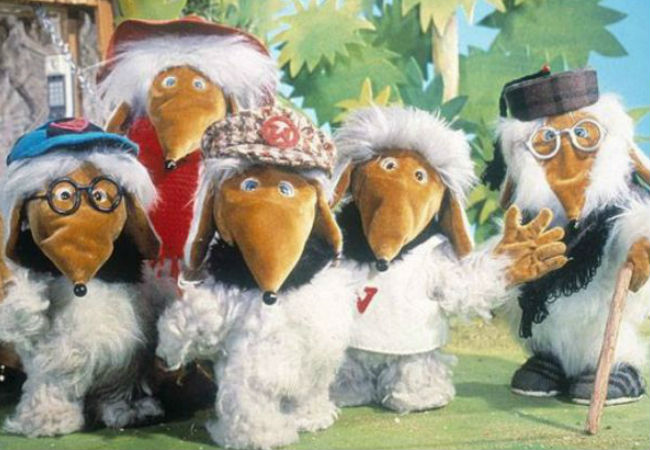
One of the fascinating aspects of looking back at characters that were a part of your childhood or youth is discovering, often quite profoundly, just how much they mean to you way back when.
Of course as an eight-year-old in 1973 I wasn’t sitting in front of the TV engaging in self-administered pop psychological analysis; all I cared about was that the characters were entertaining, the stories were engaging (yes, an avid reader, that mattered to me even then, though not necessarily in those words) and I had a lovely time being a part of their world.
But looking back it occurred to me as both an endless recipient of bullying all the way through school (and thus a social outcast who pretty much had myself for company; good thing I was adept at amusing myself with books, imaginative games etc) and a budding conservationist who cared about the environment (you can thank the great Gerald Durrell and National Geographic magazines for that) that the shows I watched also fulfilled an important need for me to feel safe and a part of something altogether removed from my life that was lovely and life-affirming into the bargain.
The Wombles, which ran for two seasons and 60 episodes from 1973, and which were based on the wonderful books by Elisabeth Beresford, starting with The Wombles in 1968 and concluding with The Wombles Go Round the World in 1976, excelled at meeting a need I couldn’t even name at the time.
Everything about the premise delighted and entranced from the cosy burrow made out of recycled materials such as newspapers and lolly wrappers for wallpaper and wardrobe doors for room entrances to the love and companionship that all the Wombles of Wimbledon Common are we gained from each other through to the charming, earworm-worthy title song by Mike Batt (who managed to garner a string of Wombles Top 40 hits through the ’70s).
Watching the episodes again for this nostalgic post I was struck by how much each episode managed to cram into each episode.
Take the episode “The Rocking Chair”, which was broadcast in the UK on 6 February 1973, where lazy but lovable Orinoco, avoiding work as usual – napping is productive right? At least that’s what he thinks – somehow gets stuck in a tyre while out rubbish collecting and after being rolled back to the burrow by Bungo or Tomsk, found his inadvertent find being turned into new rocking chair supports by resident engineer Tobermory for the clan’s leader Great Uncle Bulgaria.
In five minutes, we get an insight into Orinoco’s predilection for doing as little work as possible, the close friendship between Bulgaria and Tobermory, who have been friends for years, how the Wombles recycle their finds into something useful – their slogan was “Making good use of bad rubbish” an environmental message of the time that is just as relevant and meaningful now – the warmth and companionship of their family group and the series’ love of slapstick and verbal asides (all characters were voiced by Bernard Cribbins.)
That’s a lot to pack into a very short running time but it comes across as effortlessly charming, a hallmark of all 60 episodes which were as much about who the Wombles were as what they did, and which kept you engaged from start to finish despite the low key approach they took.
As a kid who felt very unsafe anywhere but home – I was lucky to have a very loving family and siblings I mostly liked to counteract the terrors that lay outside the door – everything about the Wombles seemed delightfully paradisaical to me.
I loved how hidden away and quirkily ramshackle the burrow was; it felt like a real home and when you’re wanting to be anywhere but your real life, there’s something deeply, profoundly appealing about seeing a home which was not only full of love and warmth – sure Bulgaria could be crotchety but he ultimately had a nurturing heart – but safe from the outside world.
Still, even as a kid I knew I had to exist somehow in that outside world, so I wanted it to be one that was well looked after.
The Wombles dedication and commitment to keeping the environment clean and safe from the ravages of our modern consumer age warmed the heart of a kid who could, even back in them that olden days, tell we were doing some pretty nasty things to the planet.
The thing is the series, directed by Graham Clutterbuck using stop-motion animation, never resorted to ranty preaching; it would have looked faintly ridiculous but wouldn’t have fit the look and feel of the show anyway.
Rather by showing everyone scooping up the rubbish and using it well including the lovely cook Madame Cholet, schoolmistress Miss Adelaide and her assistant Alderney, we got a glimpse into what it’s like to live a sustainable kind of life.
Granted ours will be nowhere as magical as that of the Wombles – I’m still waiting for my very own cosy burrow thank you – but it is necessary and can happen and I admire Elisabeth Beresford for managing to tell thoroughly charming stories and spruik a message without once feeling heavyhanded or forced in her delivery.
But most of all the series, which was revived in the ’90s when Canadian company Cinar Films bought the original producer FilmFair (52 episodes were produced between 1997 and 1998), was simply a joy to watch and live in, a world so perfectly and lovingly formed that it remains every bit as enchanting and wondrously reassuring now as did more than four decades ago.